Tag: Workouts
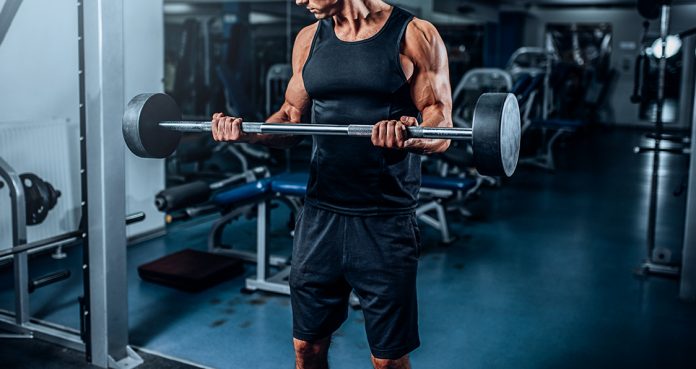
Follow This 4-Week Forearms Workout Plan To Turn Your Tiny Twigs Into Wood Logs
Follow This 4-Week Forearms Workout Plan To Turn Your Tiny Twigs Into Wood Logs
Forearms are the under-loved siblings of the bis and tris. The majority of people think that training biceps will automatically build their forearms. The said overlooking is why most people limit their forearm training to a couple of sets at the end of their arm workouts.
If you feel that your forearms are lagging as compared to your upper arms, it’s time you stop treating them as accessory muscles. A pair of beefed-up forearms can add to the symmetry of your arms and make them look bigger.
The Best 4-Week Forearm Building Workout
Week 1
Reverse Grip Barbell Curls – 5 Sets 20-20-15-15-12 Reps
Dumbbell Hammer Curls- 5 Sets 20-20-15-15-12 Reps
Preacher Curls – 5 Sets 20-20-15-15-12 Reps
Towel Cable Rows – 5 Sets 20-20-15-15-12 Reps
Behind the Back Barbell Crush – 5 Sets 20-20-15-15-12 Reps
Since the forearms are a small muscle group, you don’t need to dedicate entire workouts to training it. If you have weaker lower arms as compared to your bis and tris, you should begin your arm training with them.
We would recommend that you train bis and forearms or tris and forearms on a single day. Targetting the three muscles together on the same day isn’t going to be as effective as focusing on two.
If you don’t already carry a hand towel to the gym, you should get used to bringing not one but two wipers. Using the hand towels recruits all the muscle fibers in your forearms as it makes holding onto the weight harder.
Week 2
Wrist Curls – 5 Sets 20-20-15-15-12 Reps
Close Grip Bench Press – 5 Sets 10-8-6-5-4 Reps
Cable Kickbacks – 5 Sets 10-8-6-5-4 Reps
Barbell Skullcrushers – 5 Sets 10-8-6-5-4 Reps
Farmer’s Walk – 5 Sets 1-Minute Walk
The second week’s workout will be a triceps and forearms session. In the first and third week, you can club the tricep workout with your chest session. Train your biceps with your back in the second and fourth weeks.
You’ll be performing a lower number of reps in your tricep exercises as compared to the bicep exercises. Triceps are mostly formed of fast-twitch muscle fibers and respond better to lower reps and heavier weights.
In all the exercises you perform, make sure you’re focusing on your forearms and maintaining a mind-muscle connection. While doing the farmer’s walk, hold onto a heavy pair of dumbbells so that you have to struggle past the 30-second mark.
Week 3
Towel Kettlebell Curls – 5 Sets 20-20-15-15-12 Reps
Reverse Grip 21s – 5 Sets
Zottman Curls – 5 Sets 20-20-15-15-12 Reps
Behind the Back Cable Curls – 5 Sets 20-20-15-15-12 Reps
Wrist Rollers – 5 Sets 10 Rolls Up 10 Down
If you don’t have access to kettlebells in your gym, you can use the good-old dumbbells instead. You might have performed the 21’s but the reverse grip 21’s are a whole new game.
Zottman curls are one of the most underutilized arm training exercises. The Zottman curls are arguably the most brutal exercise on the list and you’ll have to keep your ego in check while performing it.
Week 4
Cable Pressdowns – 5 Sets 10-8-6-5-4 Reps
Reverse Wrist Curls – 5 Sets 20-20-15-15-12 Reps
Single Arm Overhead Tricep Extensions – 5 Sets 10-10-8-8-8 Reps
Grip Crush – 5 Sets 20-20-15-15-12 Reps
Dead Hangs – 5 Sets 1-Minute Each
Most people make the mistake of lifting too heavy when it comes to forearm training. Going overboard with the weights while training your lower arms can result in an injury as the wrists are relatively smaller joints and aren’t meant to take the constant tension produced by exercises like the wrist curls.
In the forearm training, your aim should be to go after the pump rather than trying to kill the muscles with heavier weights. You can push the envelope with the intensity in lower arm training with exercises like the grip crushes as there isn’t any wrist curling involved.
How often do you train your forearms? Let us know in the comments below. Also, be sure to follow Generation Iron on Facebook and Twitter.

Gym Crush – Emily Skye
Image via Instagram @emilyskyefit
Mum to Mia – Emily Skye
Instagram is full of gorgeous fit women. Chances are you might already be following a ton of fitness celebrities on Instagram. It is important you follow people who’re not just pretty but can motivate you to get off your butt and get in shape.
Emily Skype is a bundle of inspiration and beauty who can inspire you to work on your body. Emily is a new mom and is a must follow for women who want to stay fit before, during and after pregnancy.
Picture perfect, isn’t it? We spent a good amount of time trying to find a fault in this picture but failed miserably. Emily is a well-known athlete in the fitness industry and posts uplifting content on her Instagram.
Emily was ranked #3 in Forbe’s list of Top Fitness Influencers in the world. Skye had been lifting weights for the past 7.5 years and was recognized by Forbe’s in 2017. Emily also has a sneaker coming up in 2018 in collaboration with Reebok.
If you’re someone who doesn’t have the time to hit the gym every day, Emily has some workouts you can do at home. Once you follow Skye on Instagram you will have no excuses to miss a workout.
This Australian beauty looks flawless in every shot and does so with total ease. Emily is a transformation expert and helps people lose weight and get the bodies of their dreams by helping them with their diet and training.
Skye’s workouts aren’t limited to glutes and legs. Emily focuses on building a symmetrical physique and her workouts are in-line with this approach. Skye’s workouts are sure to make you break a sweat, so you better get used to it.
Oh, and did we tell you Emily has some famous friends? Skye is a regular in popular Hollywood events and appears on the cover of magazines. The world listens to what Emily Skye has to say.
Emily Skye has documented her pregnancy beautifully. From their pregnancy announcement to the birth of their baby, Emily and her husband have shared the entire journey with their fans.
No woman would mind a transformation like this. Pregnancy can make you stronger, in every way, than you could have ever imagined. You too should document your pregnancy like Emily, and you will thank yourself for it later.
So you say working out with a kid in the house is hard. Why don’t you follow Skye’s lead and make your baby workout with you? The sooner your little one starts working out, the better.
Emily can rock any outfit and this outfit is a proof of it. Skye is from the ‘lifting weights can make a woman look sexier’ club, and we couldn’t agree more. If you’re planning to start your fitness journey or need some motivation to keep going, Emily Skye is a must follow.
Who is your gym crush? Let us know in the comments below. Also, be sure to follow Generation Iron on Facebook and Twitter.
*Header image courtesy of Instagram
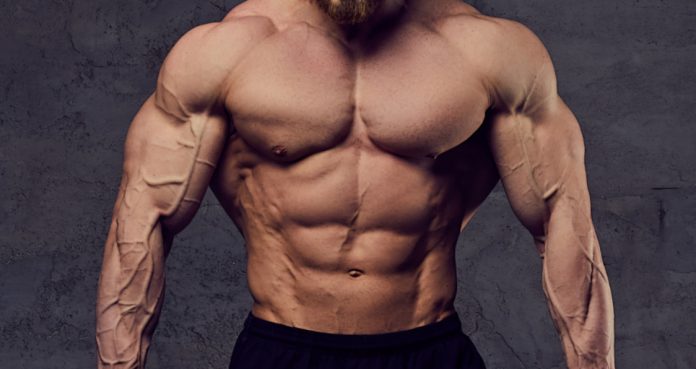
One Trick To Take Your Gains To The Next Level
Use this trick to boost your gains.
Of all the people who join a gym, only a few reach their goals. Not achieving the desired results even after working hard can be frustrating. Most people quit working out because they can see no changes in their bodies.
Crafting a Greek god-like physique isn’t easy, but you could eliminate a lot of the pain and trouble with a single trick. Sticking to this trick separates the gym novices from the pros.
Follow a Schedule
Sticking to a schedule can help you take your gains to the next level. A schedule is a much broader concept as opposed to how some people think about it. Following a schedule is easier said than done.
Most people don’t have the discipline of sticking to a routine. Bodybuilding is a sport which requires dedication, consistency, and discipline. Lacking on a single one of these attributes can cause failure to achieve your desired results.
Workout
You should follow a schedule when it comes to working out. You should reach and leave the gym at the same time every day. Doing this helps with building muscles as your muscles subconsciously get ready for your workouts.
You also need to time your workouts. Your workouts should be short and intense. You need to get the most bang for your buck. If you follow a HIIT workout, you should be spending around 45-60 minutes in the gym, not more than this.
Eat
You can’t transform your body without adjusting your diet. If your goal is to build muscle mass, you need to amp up your protein intake. Design a nutrition plan with the amount of macro and micronutrients required every day.
The time of your meals also makes a big difference. Instead of eating three big meals, you should eat 6-8 small meals. Eating at regular intervals keeps your metabolism rate high and will help you in burning fat to produce energy.
Sleep
No matter how hard you workout in the gym or how good your diet is, you won’t see the results until your body is properly rested. You break muscle while you’re working out. These muscles repair, get bigger and stronger while you’re not in the gym.
You need at least 6-8 hours of sleep every night to build muscle mass. You should also go to bed and wake up at the same time every day. Following a sleeping routine will help you fall asleep faster and will reduce the chances of insomnia.
Cheat
This might sound counterintuitive since we’re talking about following a schedule, but you’re allowed to cheat once a week. Unfortunately, the cheating is limited to a single cheat meal. A cheat meal is important as it provides your body with an influx of carbs and fats which your body needs to process.
Your body has to work harder than usual to digest these cheat meals. Although, if you’re getting ready for a competition or a special day, you would want to avoid the cheat meals. Make sure you cheat on a schedule.
What is your favorite cheat meal? Let us know in the comments below. Also, be sure to follow Generation Iron on Facebook and Twitter.
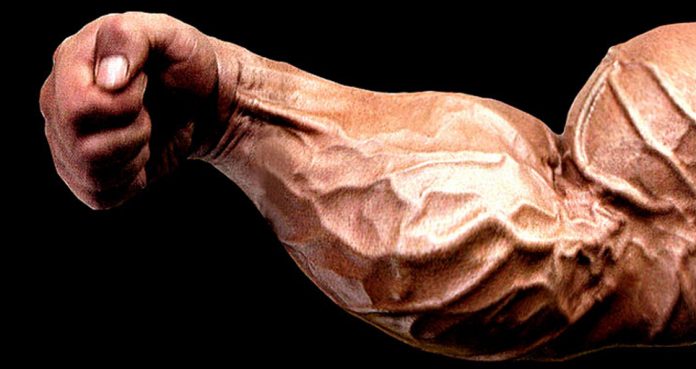
Build Massive Forearms with this Workout
Workout for Building Big Forearms
Forearms are right beside the biceps but don’t get nearly the same love as the big guns. Most people do a couple of wrists curls to train their forearms in every few weeks. The overlooking of training the forearms is a big reason many people have skinny forearms.
Muscular forearms are a symbol of strength and can add functionality by improving your grip strength. Not to mention, chiseled forearms can add to the symmetry and aesthetics of the physique.
Behind the Back Wrist Curls – 3 Sets 15-12-10 Reps
Since your forearms are a small muscles group, they will take relatively less time to recover from a working set as compared to your bis or tris. You should be able to complete your forearm workouts in 25-30 minutes.
Grab the barbell behind your back with an underhand grip. Maintain a full range of motion and curl up the barbell using your wrists. Let the barbell roll out to your fingertips at the bottom of the movement. Doing so will recruit all the muscle fibers in your forearms.
Superset
– Reverse Grip Wrist Curls – 3 Sets 10 Reps
– Wrist Curls – 3 Sets 10 Reps
The reverse grip wrist curls train the top of the forearms while the underhand grip wrist curls train the bottom of the forearm. Use a monkey grip while performing the reverse wrist curls to recruit higher muscle fibers.
Most people make the mistake of lifting too heavy weights in the wrist curls. Leave your ego out of the exercise and use weights you can lift with a full range of motion. You can perform both the superset exercise with your forearms placed on a flat bench or on your quads. Use the wrist curl machine if you have access to it at your gym.
Farmer’s Walk – 3 Sets Failure
You can do the farmer’s walk using dumbbells or a trap bar. In the farmer’s carry, you need to lift a couple of heavy dumbbells and walk around until you can’t hold onto the weights anymore.
The farmer’s carry is a great exercise to develop muscle mass and strength in your forearms. You can also perform the dumbbell or barbell holds to train your forearms. In these exercises, all you have to do is hold onto the bar for the longest time possible.
Wrist Roller – 3 Sets Failure
The wrist rollers look easier than they are. Maintaining a strict form throughout the exercise is an important factor in targeting your forearms. Extend your arms straight forward so they’re parallel to the floor while holding the wrist roller with both your hands.
Roll the weight plate up by rolling the bar towards yourself. While rolling down make sure you don’t let the weight drop by itself. Use a slow and controlled movement to lower the weight. Don’t let your arms lower down while performing the exercise.
Use Oversized Grips
One great way of targeting your forearms in every biceps exercise is to use oversized grips. Using oversized grips make it harder for you to hold onto the barbell or dumbbell and recruits your forearms into action.
If you don’t have oversized grips at your gym, you can wrap around towels around the bars to thicken the grip. If you have weak forearms, you can train them before you start your bi and tri workout as it will recruit your forearms in the arm exercises.
How often do you train your forearms? Let us know in the comments below. Also, be sure to follow Generation Iron on Facebook and Twitter.

4 Exercises You Should Stop Doing Right Now
Just like the behind the neck presses, the barbell upright rows also do a good job at activating the upper traps and medial muscles. However, they also do a good job at aggravating the shoulder tendon (rotator cuff). This can lead to shoulder impingement syndrome (SIS). Unless you don’t value your joints and tendons, this one is another no no.
3. Shrugs with Shoulder Roll
The main function of your upper traps is to raise your shoulders; so it only makes sense that doing shrugs with heavyweights will get your traps looking like the hulk. We’re good there. The problem comes in when you roll the shoulders. Rolling your shoulders at the top of a shrug actually takes the force anterior, moving off the intended target. So not only does it look stupid, it does nothing for you physically as well. This one is a no brainer, literally.
4. Twisting Sit-ups
While we’re not vilifying sit-ups here, the reality is any sort of crunch or sit-up rounds your lumbar spine forward which is called a flexion. A flexion puts an extreme amount of pressure on the lumbar discs.
The only thing worse than a flexion is a flexion with rotation which is exactly what you’re doing with a twisting sit-up. This not only brings pressure to the jelly like center of your lumbar disc, but pushes the discs in a less than ideal position which is where herniated discs tend to happen.
These are the 4 exercises you should either stop doing or modify right now; not because they don’t build muscle but because you can find more efficient ways of building without injury. Common wisdom isn’t alway so wise and as builders we have to learn to question everything. Next time you’re in the gym and see a fellow fitness freak putting himself in harms way, you now have the knowledge and the tools to help a brotha (or sista) out!
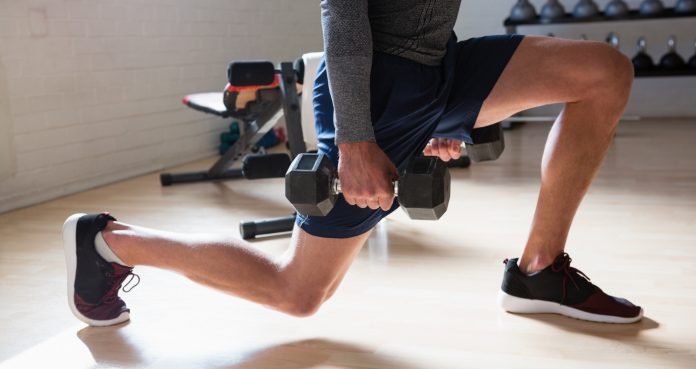
Eight Best Dumbbell Exercises for Your Glutes
Eight Best Dumbbell Exercises for Your Glutes
In theory, we train our glutes all day by walking, taking stairs instead of elevators, and by moving as nature intended. We should squeeze those glorious butt cheeks one at a time all day long, even when trapped in a meeting, stuck at a desk, or snarled in traffic.
In reality, we ignore our glutes. Not only that, we deactivate them by sitting on them, a major problem in our sedentary culture of working in cubicles and camping out on couches. This tightens the hips, flexes our bodies forward, and contributes to a chain of muscle dysfunction and pain. It also leaves us with flat, unattractive rear ends.
Some world-class butts are the product of genetics, but most are the result of work in the gym. Studies suggest that training the glutes reduces back pain. It’s possible to open the hips and unflatten your ass through training.
In this dumbbell workout, we’ll work the glutes through four sets of these eight moves in a circuit fashion, resting only briefly between sets, to produce maximum results with minimal time and equipment.
Inverted Hamstring
What it does: This move forces you to fire (activate) your glutes. Practicing such movements becomes a habit in the gym and everyday life.
How to do it: While holding dumbbells, balance on your right foot, keeping tummy tight, and shoulders back and down. Bend at the waist with both hands out to the sides and extend your left leg back as you fire the left glute. Your shoulder and heel should move together, forming a straight line. Return to starting position and switch legs.
How many? 10 on each leg.
Squat-to-Press, One-Arm Dumbbell
What it does: It challenges the glutes while also challenging your overall core stability.
How to do it: Standing with feet shoulder-width apart, hold a dumbbell on one shoulder with that elbow pointed down. Squat until your thighs are parallel to the floor. Push through the hips to stand and press the weight overhead. Lower the weight to starting position. Finish the set with one arm before switching arms.
How many? 10 on each side.
Lateral Lunges
What it does: Lateral movement is important to the motions of everyday life, but too often we ignore it in the gym. The lateral lunge hits the glutes, along with the quads and hamstrings.
How to do it: Stand holding a dumbbell in each hand at your sides. Step out to the right, keeping toes pointed straight ahead and feet flat. Squat down only your right leg, keeping the left leg straight. Squat as low as possible, keeping the left leg straight and holding for two seconds. Return to the starting position and repeat for a set of 10. Switch sides.
How many? 10 reps per side.
One-Legged Squats
What it does: This not only challenges your glutes – one at a time – but your overall balance and core strength.
How to do it: Stand on one foot holding dumbbells on your shoulders with elbows pointed out. Squat on one leg until your thighs are parallel to the ground – or as parallel as possible. Return to a standing position using only the leg you’re balancing upon. Do 10 on one side and then the other.
How many? 10 reps per side.
Weighted Glute Bridge
What it does: It’s one of the best moves to improve the activation patterns of the glutes. The dumbbells add a further strength challenge.
How to do it: Lie faceup on the floor with knees bent 90 degrees and feet on the floor. Hold dumbbells along each leg. Squeeze your glutes and bridge your hips to the ceiling. Only your shoulders and hips remain on the ground. Hold for two seconds and then lower your hips toward the ground without touching.
How many? 10 reps.
Reverse Lunges
What it does: It’s impossible to do this without actively firing your glutes.
How to do it: Stand with feet hip-width apart, holding a pair of dumbbells. Keeping the eight mostly on the front foot, step back into a lunge. When the back knee is just off the ground, push through the front hip to a standing position. Repeat with the opposite leg.
How many? 10 on each side.
Split Squats
What it does: Squatting in the gym and daily life works the glutes, but the split version with dumbbells places them fully on stretch.
How to do it: Step out into a lunge with dumbbells at arm’s length at your sides. Lower your hips by squatting back and down. Without letting your back knee touch the floor, drive your weight back up with the front glute. Do 10 sets on one leg and then repeat with the other.
How many? 10 to each side.
Romanian Deadlift
What it does: Perhaps the most recognizable hamstring move, and for good reason; it’s effective in building the proper activation patterns in your hamstrings and glutes while also strengthening your back.
How to do it: Start with a light set of dumbbells. Form is especially key to getting the full benefit from the RDL; don’t think of the exercise as bending forward but rather as sitting back with your torso moving forward instead of staying upright.
How many? 10 reps.
Pete Williams is a NASM-CPT and the author or co-author of several fitness books, including Core Performance and Every Day is Game Day. His work has appeared in multiple publications such as Men’s Health, Men’s Journal, and USA Today.
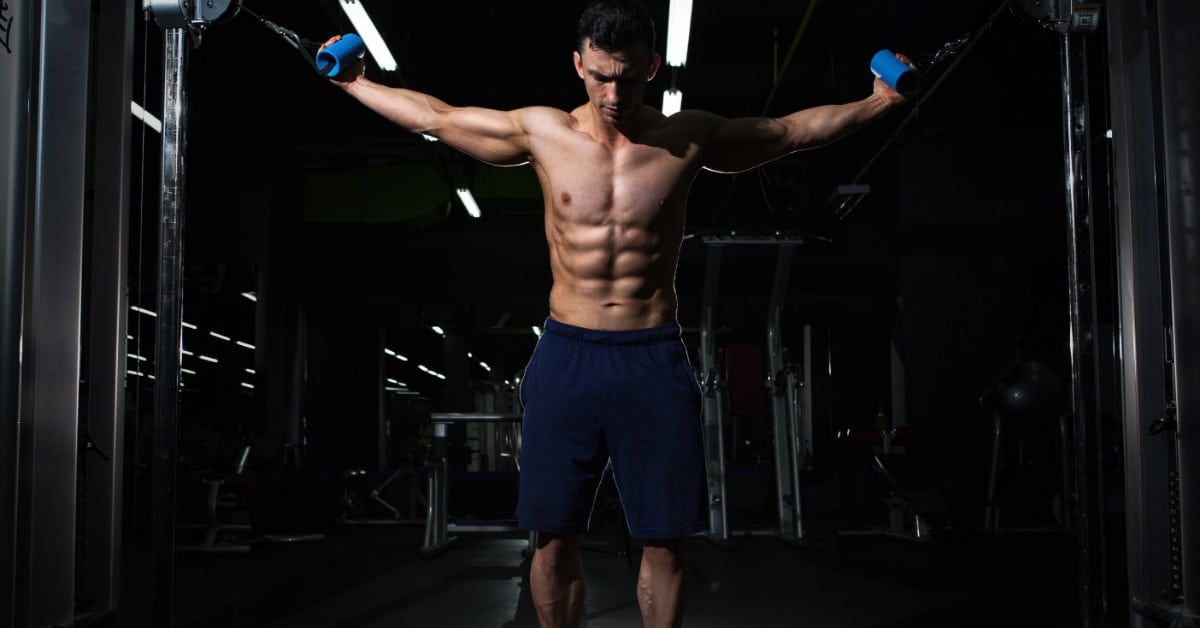
Get Ripped in 2022 with this 12-Week Easy-to-Follow Diet & Training Program
Getting in better shape is usually one of the top three New Years’ resolutions for most people. This does not only apply to people who have never stepped foot inside a gym. Even lifters who have been working out for several years aim to put on a few extra pounds of muscle mass or trim down their body fat percentage every year.
Contrary to what anyone might tell you, having a fitness-related New Years’ resolution is not wishful thinking. It is, in fact, one of the best things you can do before starting a new year.
Why is that, you ask?
According to studies, being physically active has been shown to have many health benefits, both psychological and physiological. It can also help you live longer.
Expectation Setting Before Starting a Transformation Program
To be honest, it is unfair to label people as quitters who give up working out only a few weeks after joining a gym. Most of these individuals end up quitting because they do not know what to expect in the first place.
Their failure should actually be attributed to people who initiated them in the fitness lifestyle or the trainers who could not guide them in their journey.
If you do not know what to expect while starting a training program, do not worry. We have you covered. Here is what to expect when you first join a gym:
1. It is Going To Take Time
Although transforming your physique is not as hard as some people make it out to be, it surely will test your mettle. Body transformation is a long and slow process, and you should not even consider getting a gym membership if you are giving yourself anything less than six months.
But isn’t this a 12-week transformation guide?
Yes, it is. Give that chest a rest!
Although we are giving you a 12-week program, you better not expect to turn into Captain America in these three months. We believe in keeping it real here.
To see meaningful progress, you should repeat the regimen for another 12-weeks. Even then, you should not expect to look like Steve Rogers after he came out of the Vita-Ray machine.
After six months, you will start seeing your body getting into shape. At this point, you will need to switch to an intermediate training program to take your gains to the next level.
Next Read: This Is How Your Training Should Change as You Get Advanced
2. You Are Not a Lone Wolf
There is no shortage of fitness noobs who think they have mastered the game after watching a few YouTube videos. Body transformation is a complex subject.
What has worked for a YouTuber or an Instagram fitness model might not work for you. If you want to make the most of your time in the gym, you will need a personalized transformation program.
Guessing that you are a newbie, and a humble one at that, you should take the help of a professional with a proven track record to devise your training, nutrition, and recovery program. It might cost you a little upfront, but it will pay dividends in the long run.
3. Do Not Trust Your Training Buddy
If you have joined a gym along with a buddy, you are at higher odds of giving up on your transformation compared to individuals who start alone.
Confused? Let us explain.
Beginners who start their transformation journey with a buddy usually end up becoming codependent. This relationship usually translates into one person skipping a workout because the other was too busy to hit the gym on a particular day.
Over time, these missed workouts add up and are equivalent to taking one step forward and two steps back. If you are a beginner, it is better to draw intrinsic motivation and join a gym alone as compared to joining with a friend.
Related: 5 Tips For A Weight Room Beginner
4. Working Out is Only Half the Game
Many newbie lifters pat themselves on the back after every workout as they drive to a friendly neighborhood McDonald’s for a rewarding meal.
A transformation takes much more than running 20 minutes on a treadmill or curling dumbbells for a few reps. To carve your dream physique you need to watch what you eat and follow an effective recovery program. It is called a fitness lifestyle for a reason.
5. Use Supplements
Most beginners make the mistake of staying away from sports supplements for the first few months as they think these supps are only meant for pros. On the other hand, some suspecting noobs shun supplements altogether because they think they can harm their kidneys.
Not only are bodybuilding supplements (from reputed brands) safe, but they can help shorten your transformation curve. There are supplements on the market that can improve the quality of your workouts, keep you energized intra workouts, and then fasten up your recovery process.
Here are the supplements we recommend:
12-Week Beginner Diet Program
Until you replenish your muscles with the right fuel, you should not expect to see the desired results. Your daily macronutrient (carbs, protein, and fat) needs will depend on your current weight and transformation goal.
As a beginner, you do not need to change your diet every week. You need to give your muscles enough time to make the most of the nutrients you are feeding them. By switching your meals too often, you end up leaving gains on the table.
12-Week Beginner Diet Plan
You will be eating six small meals throughout the day. This will ensure you are maintaining a high metabolism rate which will help you burn calories all day long.
The 12-week diet plan to get you shredded:
Monday
Meal 1
Oatmeal: 1 cup
Apple: 1 large
Egg white: 7 large
Multivitamins: 1 serving
Fish oil: 1 serving
Meal 2
Cottage cheese: 1 serving
Brown rice: 1 cup
Meal 3
Tuna: 1 sandwich
Meal 4
Chicken breast: 250 gms
Brown rice: 1 serving
Olive oil: 1 tbsp
Meal 5
Potato: 1 medium baked
Steak: 150 gms
Brocolli: 1 cup
Meal 6
Egg white: 3 large
Protein shake
Also Read: 10 Gym Terms Every Beginner Needs To Know
12-Week Beginner Training Program
The 12-week beginner training plan will introduce you to a range of gym equipment and functional exercises. In this program, you will work towards improving your muscle mass, conditioning, endurance, and stamina.
In the first six weeks, you will be performing full-body circuit workouts. During the second half of the program, you will switch to upper and lower body splits with increased intensity.
Other than weight training, you will also be doing cardio throughout the 12 weeks. For the first six weeks, you will be doing a 30-minute LIIT (low-intensity interval training) cardio post-workout. From weeks 7-12, you will be performing a 10-15 minute HIIT (high-intensity interval training) cardio session post-workout.
Must Read: Dear Beginner, Please Stop Making These 10 Fatal Mistakes
Training Principles For Optimal Results
To get the most out of your training, you should be following these training principles:
1. Focus on Your Form
Most beginner lifters make the mistake of chasing heavier weights while starting out. In your initial days, you should focus on perfecting your form. Learn how to perform the exercises correctly, and the weights will come.
2. Mind-Muscle Connection
If your goal is to build muscle mass, lifting weight for the sake of it is not going to cut it. Bodybuilding and weightlifting are two different sports. For optimal muscle fiber stimulation, you should focus on contracting your muscles with every rep. Remember: Bodybuilders are primarily pump-chasers. If you do not get a muscle-ripping pump during your workout, you are doing something wrong.
Check Out: 10 Myths Most Fitness Beginners Believe
3. Visualization
This technique was popularized by Arnold Schwarzenegger. As soon as the Governator entered a gym, he started visualizing what he wanted his muscles to look like. He used the rest time between sets to pose and visualize his dream physique.
“Every crunch, every chin-up, every curl, every squat, every rep brought me closer to my vision of becoming Mr. Universe, the greatest bodybuilder of all time.” – Arnold Schwarzenegger
Must Read: Arnold Schwarzenegger Quotes to Keep You Motivated
4. Progressive Overload
To avoid hitting a plateau, you need to ensure you are progressively overloading your muscles. Since this is a beginner’s training program, you do not need to push yourself too hard. Try to lift a little heavier every week or perform a couple more reps with the same weight to keep challenging your muscles.
12-Week Beginner Workout Regimen
This beginner training program will introduce you to a variety of exercises performed with a barbell, dumbbells, cables, and machines. The 12-week workout includes:
Week 1-6: Total Body Circuit
The first six weeks will help you get accustomed to resistance training and are designed to ease you into your gym life.
Monday: Workout
Tuesday: Rest
Wednesday: Workout
Thursday: Rest
Friday: Workout
Saturday: Rest
Sunday: Rest
Week 1-3:
For the first three weeks of the program, you will be performing each exercise for one set of 15 reps. Make sure you are maintaining high intensity throughout your workout. Do not rest for more than 60-90 seconds between sets.
Lying Leg Curl: 1 set of 15 reps
Leg Press: 1 set of 15 reps
Leg Extension: 1 set of 15 reps
Flat Bench Press: 1 set of 15 reps
Dumbbell Press: 1 set of 15 reps
Dumbbell Shrug: 1 set of 15 reps
Tricep Pushdown: 1 set of 15 reps
Barbell Curl: 1 set of 15 reps
Back Extension: 1 set of 15 reps
Standing Calf Raise: 1 set of 15 reps
Barbell Wrist Curl: 1 set of 15 reps
Crunch: 1 set of 15 reps
Low-Intensity Treadmill: 30-minutes
Week 4-6:
For the second phase of the first six weeks, you will be using slightly heavier weights and be performing two sets of every exercise.
Leg Press: 2 sets of 12 reps
Leg Extension: 2 sets of 12 reps
Bent-Over Barbell Row: 2 sets of 12 reps
Incline Bench Press: 2 sets of 12 reps
Dumbbell Press: 2 sets of 12 reps
Barbell Shrug: 2 sets of 12 reps
Rope Tricep Pushdown: 2 sets of 12 reps
Dumbbell Curl: 2 sets of 12 reps
Back Extension: 2 sets of 12 reps
Standing Calf Raise: 2 sets of 12 reps
Barbell Wrist Curl: 2 sets of 12 reps
Crunch: 2 sets of 12 reps
Low-Intensity Treadmill: 30-minutes
Next Read: 5 Tips for Finding Yourself a Workout Partner
Week 7-12: Upper/Lower Body Split With Increased Intensity
In weeks 7-12, you will be splitting your training days into upper and lower body workouts. You will also be pushing harder in the final installment and lifting heavier than you did in the first six weeks.
Week A:
Monday: Workout 1
Tuesday: Rest
Wednesday: Workout 2
Thursday: Rest
Friday: Workout 1
Saturday: Rest
Sunday: Rest
Week B:
Monday: Workout 2
Tuesday: Rest
Wednesday: Workout 1
Thursday: Rest
Friday: Workout 2
Saturday: Rest
Sunday: Rest
In the first week, you will be training your upper body twice, while on alternating weeks, you will be training your lower body twice a week.
Workout 1: Upper Body
Decline Bench Dumbbell Press: 2 sets of 10-12 reps
Cable Fly: 1 set of 10-12 reps
Single-Arm Dumbbell Row: 2 sets of 10-12 reps
Seated Cable Row: 1 set of 10-12 reps
Seated Dumbbell Press: 2 sets of 10-12 reps
Dumbbell Lateral Raise: 1 set of 10-12 reps
Dumbbell Shrug: 2 sets of 10-12 reps
Tricep Pushdown: 2 sets of 10-12 reps
Barbell Curl: 2 sets of 10-12 reps
Barbell Wrist Curl: 2 sets of 10-12 reps
HIIT Treadmill: 10-15 minutes
Workout 2: Lower Body
Smith Machine Squat: 1 set of 8-12 reps
Leg Extension: 1 set of 10-12 reps
Lying Leg Curl: 1 set of 10-12 reps
Back Extension: 1 set of 20-30 reps
Standing Calf Raise: 1 set of 12-15 reps
Crunch: 2 sets of 15-40 reps
Reverse Crunch: 2 sets of 15-30 reps
HIIT Treadmill: 10-15 minutes
Next Read: 7 Reasons Why You Can’t Build Muscle
Conclusion
While getting a gym membership is easy, sticking to a transformation program requires determination and unwavering commitment. Although the first few months of a transformation program might get you no visible results, you will see exponential growth in the months that follow.
If you wish to carve the physique of your dreams, we encourage you to think long-term. As someone once said, “People overestimate what can be done in one year, and underestimate what can be done in ten.”
What is your current and goal weight? Let us know in the comments below. Also, be sure to follow Generation Iron on Facebook and Twitter.
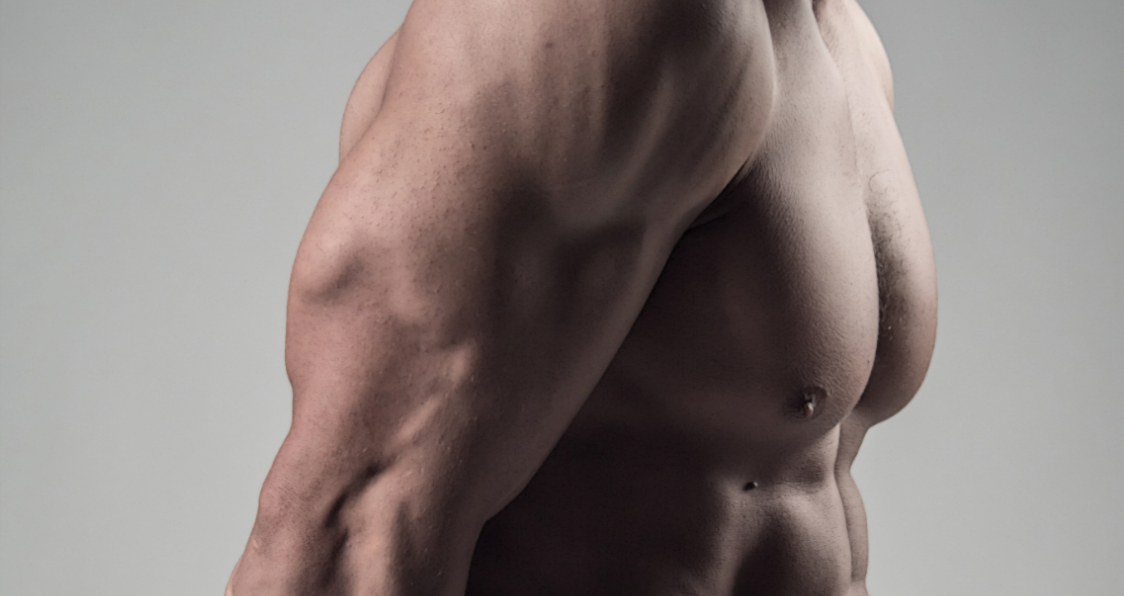
How To Perform the Perfect Skull Crusher To Build Impressive Triceps
The Ultimate Exercise for Tricep Building
Regardless of whether you are a powerlifter, bodybuilder or sports athlete, you should be performing some form of tricep strengthening exercise in your training program.
Developing the triceps can have a positive impact on both strength, aesthetics and technique. However, despite this, many still fail to perform tricep work regularly enough.
If you are looking to improve your pressing and lockout ability for exercises such as bench, dips, handstands, snatch, and jerk, then there is a great need for strong triceps.
This article will review one of the best tricep strengthening exercises that you should be doing – the tricep skull crusher.
Not only will it breakdown skull crusher technique and explain a number of the benefits associated with the exercise, but it will also provide a selection of variations and alternatives.
Skull Crusher Technique and Muscles Worked
The skull crusher is an isolation exercise that specifically works the triceps. Isolation exercises involve moving through only one joint – in this case, the elbow joint.
Although other tricep-orientated exercises, such as the close grip bench press and dips, effectively work the triceps, there are other muscles that assist in these exercises as movement occurs through multiple joints.
Both single and multi-joint exercises have been found to be effective for building strength and size (1).
The benefit of the single-joint component of the skull crusher forces the triceps to do all the work which means they receive a large training stimulus and consequently adapt greatly.
Along with the triceps, an array of shoulder stabilizing muscles must activate in order to maintain stability in the shoulder joint.
These muscles do not change in length through a concentric or eccentric contraction, they contract isometrically which means the muscles are contracted however do not change in length.
This isometric contraction, primarily of the rear delts and scapular stabilizers, holds the upper arm in place. This then allows for deep elbow flexion and to place the demand on the triceps.
Detailed below you will find a step by step guide that will allow you to perform the perfect skull crusher.
Step 1
Set up a flat bench and grab a barbell using a shoulder-width grip. Lie back on the bench and press the bar up so that it sits directly over the top of the chest. The arms should be fully extended.
Grip width can be adjusted if necessary to find a grip that suits you best. The key point to ensure that the muscles of the upper back and around the shoulder blades can engage to stabilize the shoulder joint.
Step 2
From this position, keeping the upper arms fixed, bend at the elbows so that the barbell drops down towards the head.
As the barbell lowers, ensure that the elbows are tucked in tightly and do not allow them to flare out. Concentrate on squeezing the bar and keep the upper back muscles engaged throughout this phase.
Step 3
Once the barbell is directly above the cranium with the elbows in deep flexion, let the upper arm move backwards slightly.
Doing this will increase the stretch on the triceps while simultaneously maintaining tension on the muscle at the bottom of the movement.
Step 4
From there, pull the upper arms back to their original position and powerfully extend at the elbow to bring the arms out of deep flexion and return to the straight arm starting position.
Be wary of bringing the elbows too far forward during this step as this will reduce tricep isolation and potentially increase the strain placed on the shoulder.
4 Benefits Associated With Skull Crushers
Most athletes and lifters will benefit from performing skull crushers in one way or another. Listed below you will find 4 of greatest benefits associated with the skull crusher.
1) Increasing Tricep Strength
The most evident benefit of all is the fact that the exercise strengthens the tricep muscles. Having strong triceps will be beneficial for all pressing exercises and for improving shoulder stability.
For the powerlifter, having strong triceps is essential during the bench press. Considering that the triceps control elbow extension (2) they are particularly important during the lock-out.
In Olympic Lifting, having strong triceps will facilitate a more efficient catch in the jerk and the snatch and improve overhead stability.
More generally, improving tricep strength will have a positive impact on elbow joint health.
2) More Efficient lockouts
As stated, the triceps are most responsible for locking out the elbow joint. Having a strong lockout will facilitate a better bench, jerk and snatch.
By focusing on building tricep strength and size, most athletes and lifters will improve their lockout and therefore improve their overall performance.
3) Elbow Joint Health
Appropriate strength training can improve the health of many joints throughout the body and has been found to be useful for improving bone and joint conditions (3).
Providing that volume, intensity and technique is in place, the muscles will adapt to become more efficient at dealing with forces and stress.
This will take a lot of the strain of the connective tissues that surround the joints – ligaments, tendons and cartilage.
Therefore, increasing tricep strength can help to reduce the risk of elbow injury – specifically overuse injuries.
4) Increased Tricep Size
For a number of athletes, improving muscle size is a priority. For those looking to increase arm size, it is important to heavily target the triceps.
When building mass in the arms, most individuals focus too heavily on the biceps. In actuality, the main focus should be on tricep development as the triceps take up two-thirds of the upper arm.
Therefore, increasing the size of the triceps will cause the arms to look much bigger and fuller.
Skull Crusher Variations and Alternatives
In this section, you will find 3 variations and 3 alternatives to allow you to best progress or regress your training where appropriate.
Dumbbell Skull Crushers
One of the more simple changes that can be made to the skull crusher is to use dumbbells instead of a barbell or EZ bar.
The movement required is absolutely identical however using dumbbells forces the arms to work individually. This is particularly useful for any lifter who struggles with strength imbalances or stability issues (4).
Another benefit of the dumbbell variation is that it may allow for a greater range of motion and therefore place even more stress on the triceps.
Incline Bench Skull Crushers
As the name suggests, this variation involves setting a bench on a slight incline before performing the skull crusher. Feel free to use barbells or dumbbells for this variation.
The incline will cause a greater tricep stretch and allow you to target the tricep from a different angle. Both of these can facilitate an improvement in tricep strength and size.
Skull Crusher Negatives
Negatives involve focusing on the eccentric (lowering) phase of the movement. This advanced training method has been found to increase muscle damage and boost hypertrophy (5).
To maximize the eccentric phase of the skull crusher, very slowly lower the bar for a period of 3-5 seconds until it is directly over the head.
Consider using a spotter for safety and also to allow you to maximally work the triceps.
Close Grip Bench Press
The first alternative to target the triceps is a bench press variation. Assuming a close grip on the barbell during a bench press will predominantly recruit the triceps and pecs (chest).
In order to maximize tricep activation, look to tuck the elbows in tightly to the ribcage as the barbell is lowered to the chest.
The close grip bench press is not only great for tricep development but it will also facilitate a better lockout and is the perfect bench alternative for those with shoulder issues.
Dips
Full dips performed on bars or rings are a superb mass building exercise for the chest, shoulders, and arms.
For those who are new to dips, bodyweight will more than suffice to start with. For those who are more advanced, look to use additional resistance through the use of a dipping belt.
Remember, when it comes to strength training, you must always aspire to gradually make things more challenging if you want to continually improve in strength and size
Overhead Tricep Extensions
The final alternative is probably the most similar to the skull crusher in terms of movement. This exercise can be completed using barbells, dumbbells or cables.
The benefit of the overhead tricep extension in comparison to the skull crusher is that it may be less taxing on the elbow joint which is specifically important for those with elbow issues.
As the name suggests, the exercise involves holding the load overhead with straight arms. From that position, the elbows flex to drop the weight down before driving back up to the starting position.
Final Word
In comparison to other tricep focused exercises, the skull crusher reigns supreme. Not only will it effectively increase tricep strength and size but it may also facilitate performance with other lifts.
Therefore, the skull crusher, with its many variations and alternatives, should be seriously considered when designing a strength training program.
For more news and updates, follow Generation Iron on Facebook, Twitter, and Instagram.
References:
1-Gentil, Paulo; Soares, Saulo; Bottaro, Martim (2015-6). “Single vs. Multi-Joint Resistance Exercises: Effects on Muscle Strength and Hypertrophy”. Asian Journal of Sports Medicine. 6 (2). doi:10.5812/asjsm.24057. ISSN 2008-000X. PMC 4592763. PMID 26446291.
2-Landin, Dennis; Thompson, Melissa; Jackson, Meghan (2018-4). “Functions of the Triceps Brachii in Humans: A Review”. Journal of Clinical Medicine Research. 10 (4): 290–293. doi:10.14740/jocmr3340w. ISSN 1918-3003. PMC 5827912. PMID 29511416.
3-Westcott, Wayne L. (2012-7). “Resistance training is medicine: effects of strength training on health”. Current Sports Medicine Reports. 11 (4): 209–216. doi:10.1249/JSR.0b013e31825dabb8. ISSN 1537-8918. PMID 22777332.
4-Saeterbakken, Atle H.; van den Tillaar, Roland; Fimland, Marius S. (2011-3). “A comparison of muscle activity and 1-RM strength of three chest-press exercises with different stability requirements”. Journal of Sports Sciences. 29 (5): 533–538. doi:10.1080/02640414.2010.543916. ISSN 1466-447X. PMID 21225489.
5-Vogt, Michael; Hoppeler, Hans H. (June 1, 2014). “Eccentric exercise: mechanisms and effects when used as training regime or training adjunct”. Journal of Applied Physiology (Bethesda, Md.: 1985). 116 (11): 1446–1454. doi:10.1152/japplphysiol.00146.2013. ISSN 1522-1601. PMID 24505103.
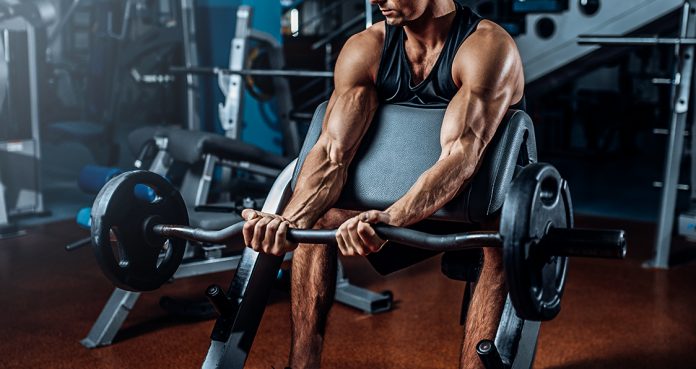
10 Exercises To Add Variety In Your Next Workout
Try these Exercises in Your Next Workout
Just like us humans, no two exercises are created equal. Most people stick to the same exercises in their workouts. Performing the same routines over and over can lead you to hit a plateau.
There are a few incredibly effective exercises which can target your muscles in a unique way. The exercises in this article will help you break the plateau and will take your gains to the next level.
Chest
Floor Dumbbell Chest Flyes
[embedded content]
Most people make the mistake of not following the full range of motion while performing the bench dumbbell flyes. The floor dumbbell flyes force you to touch the floor with your elbows at the bottom of the movement and touch the dumbbells at the top of the movement.
Incline Pin Press
[embedded content]
The upper pecs are a weak muscle group for most people. Incline pin presses are a great way to overload your upper pecs. Incline pin presses also add a layer of safety to the compound exercise.
Back
T-Bar Rows
T-Bar rows are one of the most underutilized exercises when it comes to building a thick back. The T-Bar rows were one of Arnold’s staples and they should also be a part of your exercise arsenal.
Bent Over Lat Pull-Down using Seated Cable Row
The problem with the normal lat pull-down is, you can use momentum to bring the weights down. Bent over lat pull-downs on the seated cable row will eliminate the use of momentum and you will have to use your lats to pull the weights.
Shoulders
Reverse Seated Alternate Hammer Strength Press
The normal shoulder presses focus on the anterior delts, while the reverse seated alternate hammer strength presses focus on the medial deltoids. The hammer strength presses will help you in building the separation and roundness of your shoulder caps.
Biceps
Arm Blaster Barbell Curls
[embedded content]
For most guys arms are their favorite muscle group to train. Most guys let their ego get in the way of building a nice pair of guns. The arm blaster helps in isolating your pythons and will help in building the size, conditioning, and the bicep peak.
30’s
[embedded content]
30’s will completely annihilate your biceps. In this exercise, you need to perform 10 reps of barbell curls on the bottom half, 10 reps on the top half and 10 full reps. 30’s are an extension of 21’s and are way harder.
Triceps
Cable One Arm Triceps Extensions
[embedded content]
Most people go too heavy on the cable triceps extensions and lean onto the bar. Stand straight next to the cable pulley machine and maintain a full range of motion. Hold and squeeze your triceps at the bottom of the movement.
Legs
Platz Hack Squats into Sissy Squats
[embedded content]
Tom Platz arguably had the sickest legs in the bodybuilding industry. One of his not-so-secrets were the Platz hack squat into sissy squats. This exercise targets your quads and will help you in building that tear-drop.
Good Mornings
[embedded content]
It is harder to develop your hamstrings as compared to your quads as you can’t see your hamstrings in the mirror and it is harder to develop a mind-muscle connection with them. Maintain a slight bend in your knees, push your hips back as you bend to lower the barbell. Imagine using your hams to lower the weights as compared to your back. Doing this will help you get a better pump.
Which is your favorite exercise? Let us know in the comments below. Also, be sure to follow Generation Iron on Facebook and Twitter.
*Header image courtesy of Envato Elements.
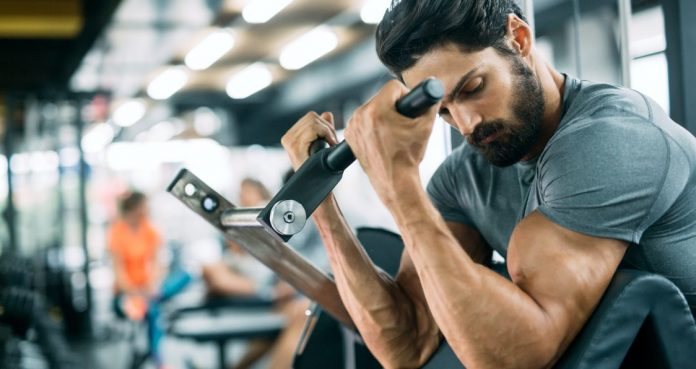
The Machine-Only Bicep Workout For Building Huge Biceps
This Machine-Only Bicep Workout Will Give You Intergalactic Gains
Big biceps have been the symbol of machoism and badassery for ages. Getting girls and building big biceps are two of the most common reasons why people get a gym membership. If building your guns was easy, everyone would be walking around with mountain like biceps.
Most people make the mistake of overly depending on dumbbell and barbells for building their pythons. Following the same workout routine can make you hit a plateau. You need to constantly shock your muscles to make them grow.
1. Cable Curls – 3 Sets 20 Reps
Cable curls are a great exercise for pre-exhausting your guns at the beginning of your workouts. Performing cable curls on a straight bar help with building overall size in your biceps. Cable curls are a substitute for the barbell curls.
Using cables helps you maintain a constant tension on your muscles throughout the exercise. While using the free weights, you have tension on your target muscle on the concentric movement but have no stress on the eccentric movement.
2. Cable Preacher Curls – 3 Sets 12 Reps
You haven’t experienced true isolation until you perform the cable preacher curls. Use the preacher curl machine if you have an access to it at your gym. Otherwise, set up the preacher curl bench on the cable machine.
Set the cable pulley and the bench so the weights don’t rack at the bottom of the movement. This will help in maintaining a constant tension on your biceps. Hold the straight bar at shoulder width and squeeze your biceps at the top of the movement.
3. Cable Rope Curls – 3 Sets 12 Reps
Cable rope curls are a substitute for the hammer curls. In hammer curls, you hold a dumbbell in each hand and your palms face each other. Hammer curls are incredibly effective at building the length of your biceps.
While performing the cable rope curls, make sure your elbows are locked in a position and you contract your biceps at the top of the movement. Keep the reps slow and deliberate to get the most out of this exercise.
4. Overhand Bicep Curls – 3 Sets 15-12-12 Reps
Most people neglect training their forearms. Not training your forearms can cause an imbalance between your biceps and forearms. Your workouts should be designed so they help you build muscle symmetry.
Use a straight bar for this exercise. Place your thumbs over the straight bar while performing this exercise. Doing this will force your forearms to recruit more muscle fibers to hold onto the bar.
5. High Cable Curls – 3 Sets 15 Reps
High cable curls are arguably one of the best bicep finishers. This exercise will help you in building a peak in your biceps. Most people let their egos get the better of them while doing this exercise. They put on more weights than they can handle.
Stand in the center of the cable pulley machine and hold a D-handle in each hand. Make sure your elbows stay fixed while you perform the curls. Pause for a second at the top of the movement and contract your muscles for optimal results.
Which is your favorite bicep exercise? Let us know in the comments below. Also, be sure to follow Generation Iron on Facebook and Twitter.
